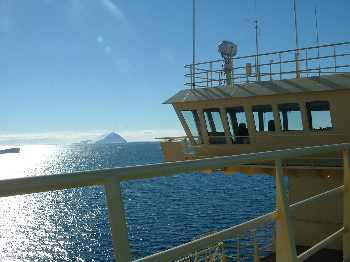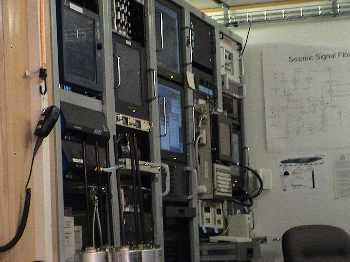5 February, 2004
McMurdo Sound has becoming very familiar to us. We look forward to
seeing Mount Erebus, and Mount Discovery. They serve as visual
markers that we are in some sense "home". Home is a place where you
are comfortable, you know your way around and there is a pattern to
the day. The pace of our day is set by the change between shifts on
watch, looking forward to meal time and time writing emails and
taking pictures.
I started watch to the news of a late night dredge. This was Dredge
#4 for the cruise. The dredge was taken in an area of a suspected
seamount at a depth of about 170 meter (530 feet). The dredge
contained less than a dozen rocks. Sam Mukasa washed each rock and
appears hopeful that there will be some that will be of interest in
his geochemistry studies. There was very little mud again in this
dredge. Long armed brittle starts and large sponges and their
feathery spicules were the organisms of the day caught in the dredge.
The people on the night watch were great. Since I was sleeping during
the dredge, they collected all the organisms and photographed them in
the hydro lab for me, so that I could continue the record of life
caught in each dredge.
We spent the rest of the morning mutlibeaming around Beaufort Island.
We observed a number of large magnetic spikes that are most likely
associated with rock that contains a high concentration of Iron atoms
that were magnetized in the earth's magnetic field as the rock
cooled. The water around Beaufort Island is less than 250 meters. Ice
and Begs have a tendency to pile up on the windward side of the
island. We have had favorable winds lately and are able to complete
regions of the seafloor maps that had been undoable previously due to
large bergs and sea ice.
By early morning, we were ready to start doing seismic again. At 9:00
AM the marine techs began getting the multichannel streamer and six
GI air guns ready to deploy. The scientists set the first shot line,
and the ship traveled to the start point. It had been a few days
since we had last done seismic, so each of the guns needed to be
checked. The air compressor that power s the guns needed to be
brought up to 2000 psi of pressure, and the firing mechanism for each
gun needed to be checked. By 11:00 AM we had six guns and the
multichannel streamer in the water. We had to make a small extra loop
to catch the start of the shot line to make sure that we had enough
time to make sure the guns were in order.
The tentative schedule calls for five days of seismic work to the
area north of Franklin Island and B15A. We will be heading out into
the open water of the Ross Sea. The weather so far has been
incredibly nice. The weather forecasts call for stormy weather. We
will have to see what the next four days bring.
I received copies of emails sent to Stuart Henrys today. Stuart is a
geophysicist from New Zealand, and he has been corresponding with
other New Zealand scientists to try and locate someone who is doing
work on lichens and mosses and also would be interested in the
mummified remains of a large sea mammal that we found on Franklin
Island. Stuart had sent digital photos of the mammal to the
scientist. Their initial identification is that the animal is a giant
elephant seal. Tests would have to be done to determine the how long
the remains have been on the Island. Part of the seal mummy is buried
under rocks cascading from the slopes above. They are looking into
having a scientist go to Franklin Island to get some samples of the
mummy before winter.
It is very exciting to see the cooperation between scientists working
in different areas. There is a real camaraderie that enhances the
science that is done by everyone, and brings opportunity to learn
things that might have gone unknown without the cooperation.

Open water as we head north of Franklin Island.

The bank of electronics equipment that controls the seismic guns and collects data from the seismic streamer.

Contact the TEA in the field at
.
If you cannot connect through your browser, copy the
TEA's e-mail address in the "To:" line of
your favorite e-mail package.
|
